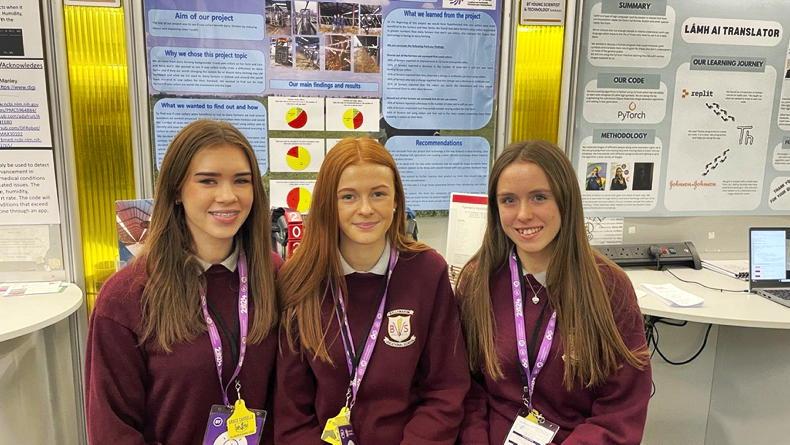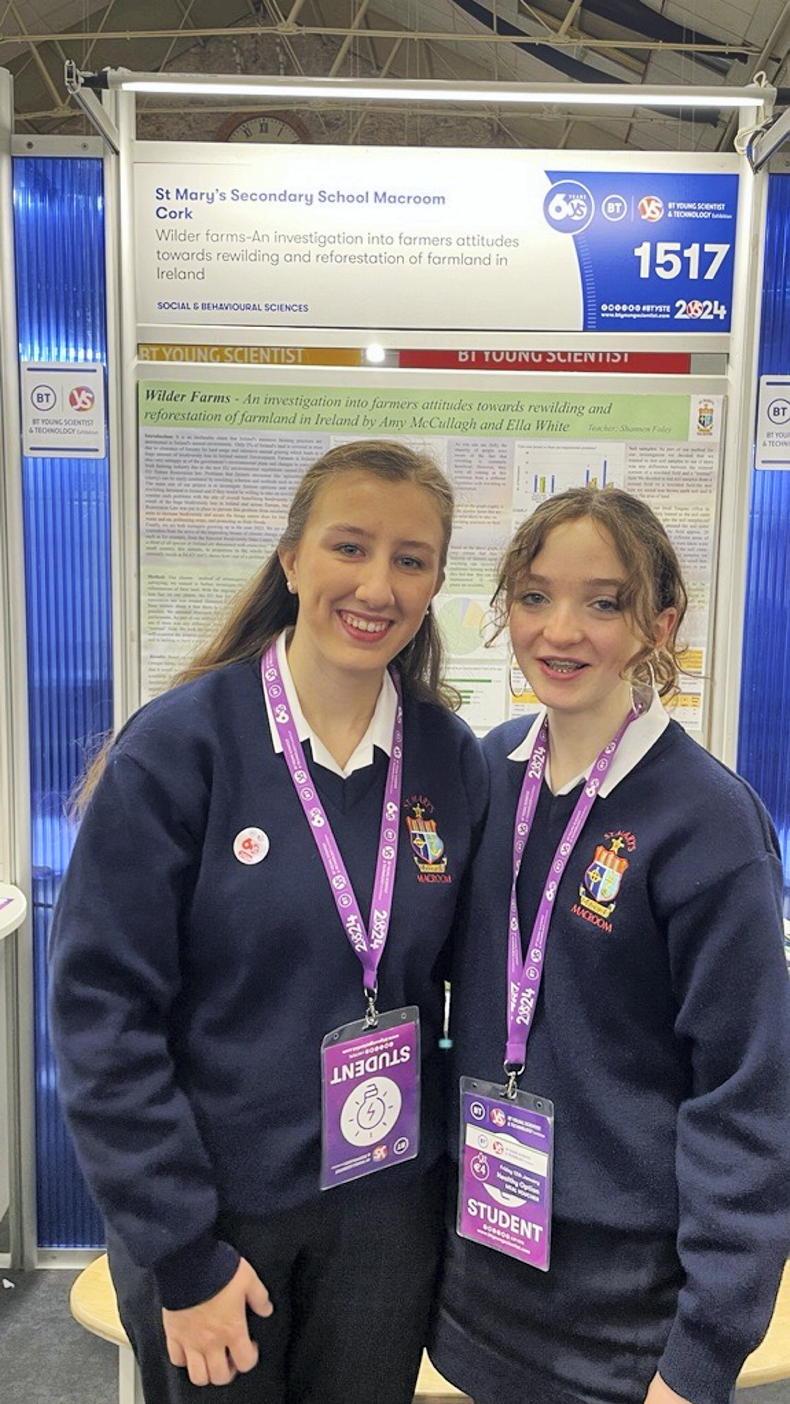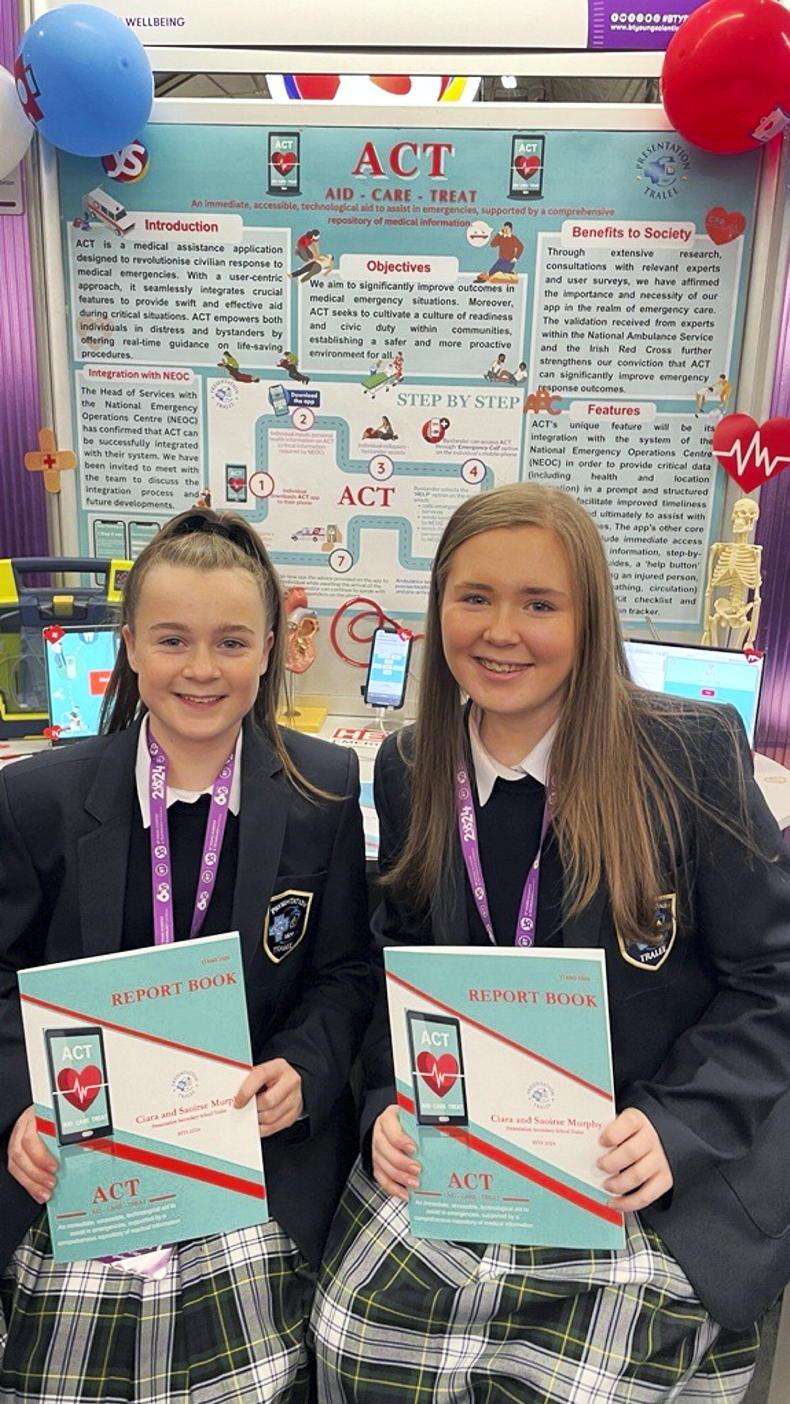Over 1,100 participants from schools across Ireland travelled to this year’s BT Young Scientist & Technology Exhibition at the R.D.S. Dublin earlier this month. The competition provides a platform for young minds to explore and showcase their talents in the field of STEM (Science, Technology, Engineering and Mathematics).
This year marked the 60th anniversary of the innovation that enables students aged 12-19 to learn how to research and explore ideas. Mari Cahalane, Head of the 2024 BT Young Scientist & Technology Exhibition, talks about the importance of promoting STEM amongst primary and secondary school students.
“By getting students involved in something that’s really tangible, that they can feel and see at the exhibition is very important,” she says. “The hope is that they come and see and then do. The visitors of today are hopefully the participants of tomorrow and the participants of this year will hopefully go on and work in STEM.” Here is a round-up of some of the most impressive agriculturally focused projects.
Let’s save the common ash: a continued story

Assistant Director of Research in Teagasc, Declan Troy, presenting the winners of the “Teagasc Special Award” to recipients Abigail O’Brien Murray, Erica O’Brien Murray and Olivia O’Shea from Loreto Secondary School Balbriggan at the recent BT Young Scientist Exhibition 2024.
An investigation into the positive interplay of Jasmonic and Salicyclic acid on H. fraxineus inhibition, whilst maintaining the typical growth of Fraxubys Excelsior.
Abigail O’Brien Murray, Erica O’Brien Murray and Olivia O’Shea from Loreto Secondary School Balbriggan, Co Dublin won the ‘Teagasc Special Award’ for their project focused on saving ash trees.
Olivia O’Shea outlines the importance of ash trees for Ireland’s biodiversity and culture. “Currently 90% of ash trees are affected by ash dieback, causing leaf loss, bark lesions and dieback,” says Abigail. “Following on from our previous research, testing plant-pathogen interaction and the interplay between two hormones, we ran three different experiments, two in vitro and one in vivo.
“The first in vitro experiment tested the effect our treatments have on the growth of the fungus. We took collections every two weeks over five months, with six treatments in total with different concentrations and ratios of the two hormones.” They found a treatment that works significantly across all genotypes, inhibiting the fungus on average at 82.3% and up to 92%, while also having no ill effect on the overall health and growth of the tree.
Rooting for sustainability

Sean Allen from Roscommon Community School.
An exploration of more sustainable grassland nutrient management for a greener future.
Sixth year student Sean Allen from Roscommon Community School returned to the BT Science and Technology Exhibition for a third year in a row, continuing his research on addressing the issues of unsustainable agricultural practices. He focused on the mitigation of greenhouse gas emissions through the use of synthetic fertilisers.
This year, Sean’s project focused on replacing chemical fertiliser with anaerobic digestate to achieve a reduction in greenhouse gas emissions.“I tested anaerobic digestate as the alternative,” he says. “The main finding of my project was that the liquid anaerobic digestate consistently outperformed other treatments, showing a significant advantage in grass growth with 53.5% more than 10-10-20 (fertiliser).
“I did a full carbon work up on the farm and if you were to replace chemical fertiliser with anaerobic digestate, there would be 122.87 tonnes of CO2 (carbon dioxide) saved in a year. This brings you closer to carbon neutral as you are putting more organic matter into your soil and you’re going to sequester more carbon.”

Luke O’Connor, Robert O’Sullivan and Emma Byrne from Millstreet Community School, Co Cork decided to do their project on the sustainability of silage.
An investigation into the sustainability of silage preservation methods from an environmental, social and economic perspective.
Luke O’Connor, Emma Byrne and Robert O’Sullivan from Millstreet Community School, Co Cork focused their project on the sustainability of silage. All three students come from farms and were debating one day about pit or bales — which is more sustainable for farming and which is more economical and less time-consuming for the farmer?
“We conducted a statistical analysis of the plastic volume required for bales silage versus pit silage,” says Luke. “Along with other survey methods and interviews with local farmers and contractors, we found pit silage is more sustainable from an environmental, economic and social aspect. Pit covers can be reused whereas bale wrap must be recycled. Animals can be fed more efficiently with the pit resulting in a better work life balance.”
Are cow collars worth the hype?

Grace Cassells, Keira Hopkins and Lara Flood from Ballymahon Vocational School in Co Longford won the ABP sustainable farming practices award.
An investigation to see if cow collars benefit dairy farmers by reducing hard labour and improving cows’ health and wellbeing.
Students Keira Hopkins, Grace Cassells and Lara Flood from Ballymahon Vocational School in Co Longford won the ‘ABP Sustainable Farming Practices Award’. This new award is given to a project that demonstrates sustainable innovation and excellence in agriculture. Grace comes from a dairy and beef farm, Keira comes from a beef and sheep farm, while Lara is from a beef, sheep and dairy enterprise.
“We all come from farming backgrounds,” says Grace. “While we use collars on our farm, Laura and Kiera’s farms don’t. We wanted to see if they are worth the hype in terms of reducing labour and improving cows’ health.”
The students discovered 80% of farmers using collars reported an improvement in first served conception rates, while 97% of farmers also said the collars were worth the investment and they would recommend them to other dairy farmers. Meanwhile, 64% of farmers not using collars said the price is the main reason preventing them from investing.

Ella White and Amy McCullagh from St Marys Secondary School Macroom, Co Cork looked at rewilding to increase biodiversity as a result of the nature restoration law.
An investigation into farmers’ attitudes towards rewilding and reforestation of farmland in Ireland.
Amy McCullagh and Ella White from St Marys Secondary School Macroom, Co Cork looked at rewilding to increase biodiversity as a result of the nature restoration law.
“One of our major findings from our surveys was that smaller farmers are more likely to take on rewilding practices on their farms,” says Amy. “The majority of farmers also agree that rewilding can co-exist with traditional farming methods but they feel that they can only be implemented if sufficient grants are available.”
Emma adds: “Our recommendations are that the government creates a scheme or grant that considers the type of farm and land that farmers are willing to rewild so they are all fairly compensated.”

Sisters Ciara and Saoirse Murphy from presentation secondary school, Co Kerry developed an immediate technological aid app to help people in emergencies.
An immediate, accessible, technological aid to assist in emergencies supported by a comprehensive repository of medical information.
Sisters Ciara and Saoirse Murphy from Presentation Secondary School, Co Kerry developed an immediate technological aid app to help people in emergencies.
“The inspiration for our project came from a medical emergency in our family,” says Saoirse. “A relative of ours collapsed after completing a 200km open marathon race in 2022. Even though there were six of us there, none of us knew how to help him in the emergency. It just highlighted and outlined the importance of having this app to provide aid during a medical emergency.”
The main feature of the app is it is directly integrated with the system of the National Emergency Operations Centre (NEOC) in order to provide critical data and improve timeliness.

Ms Shannon Foley, St Marys Secondary School Macroom.
“We have been entering the competition for the last 12 years,” says Ms Foley. “I find that every single year it gives the students a great opportunity to stand in front of a judge, explain their project and take responsibility for their research. It’s really good not only for science but also for aiding students’ confidence.
“We are from an all-girls school, it’s really important to get them interested in STEM as there are so many opportunities for women in STEM at the moment. When they are at the competition and around this environment, they realise the opportunities out there and get the confidence they need to pursue that interest.”
See https://btyoungscientist.com/
Read more
An Garda Síochána increase age limit for recruitment drive
Increased funding for Walsh scholars
Over 1,100 participants from schools across Ireland travelled to this year’s BT Young Scientist & Technology Exhibition at the R.D.S. Dublin earlier this month. The competition provides a platform for young minds to explore and showcase their talents in the field of STEM (Science, Technology, Engineering and Mathematics).
This year marked the 60th anniversary of the innovation that enables students aged 12-19 to learn how to research and explore ideas. Mari Cahalane, Head of the 2024 BT Young Scientist & Technology Exhibition, talks about the importance of promoting STEM amongst primary and secondary school students.
“By getting students involved in something that’s really tangible, that they can feel and see at the exhibition is very important,” she says. “The hope is that they come and see and then do. The visitors of today are hopefully the participants of tomorrow and the participants of this year will hopefully go on and work in STEM.” Here is a round-up of some of the most impressive agriculturally focused projects.
Let’s save the common ash: a continued story

Assistant Director of Research in Teagasc, Declan Troy, presenting the winners of the “Teagasc Special Award” to recipients Abigail O’Brien Murray, Erica O’Brien Murray and Olivia O’Shea from Loreto Secondary School Balbriggan at the recent BT Young Scientist Exhibition 2024.
An investigation into the positive interplay of Jasmonic and Salicyclic acid on H. fraxineus inhibition, whilst maintaining the typical growth of Fraxubys Excelsior.
Abigail O’Brien Murray, Erica O’Brien Murray and Olivia O’Shea from Loreto Secondary School Balbriggan, Co Dublin won the ‘Teagasc Special Award’ for their project focused on saving ash trees.
Olivia O’Shea outlines the importance of ash trees for Ireland’s biodiversity and culture. “Currently 90% of ash trees are affected by ash dieback, causing leaf loss, bark lesions and dieback,” says Abigail. “Following on from our previous research, testing plant-pathogen interaction and the interplay between two hormones, we ran three different experiments, two in vitro and one in vivo.
“The first in vitro experiment tested the effect our treatments have on the growth of the fungus. We took collections every two weeks over five months, with six treatments in total with different concentrations and ratios of the two hormones.” They found a treatment that works significantly across all genotypes, inhibiting the fungus on average at 82.3% and up to 92%, while also having no ill effect on the overall health and growth of the tree.
Rooting for sustainability

Sean Allen from Roscommon Community School.
An exploration of more sustainable grassland nutrient management for a greener future.
Sixth year student Sean Allen from Roscommon Community School returned to the BT Science and Technology Exhibition for a third year in a row, continuing his research on addressing the issues of unsustainable agricultural practices. He focused on the mitigation of greenhouse gas emissions through the use of synthetic fertilisers.
This year, Sean’s project focused on replacing chemical fertiliser with anaerobic digestate to achieve a reduction in greenhouse gas emissions.“I tested anaerobic digestate as the alternative,” he says. “The main finding of my project was that the liquid anaerobic digestate consistently outperformed other treatments, showing a significant advantage in grass growth with 53.5% more than 10-10-20 (fertiliser).
“I did a full carbon work up on the farm and if you were to replace chemical fertiliser with anaerobic digestate, there would be 122.87 tonnes of CO2 (carbon dioxide) saved in a year. This brings you closer to carbon neutral as you are putting more organic matter into your soil and you’re going to sequester more carbon.”

Luke O’Connor, Robert O’Sullivan and Emma Byrne from Millstreet Community School, Co Cork decided to do their project on the sustainability of silage.
An investigation into the sustainability of silage preservation methods from an environmental, social and economic perspective.
Luke O’Connor, Emma Byrne and Robert O’Sullivan from Millstreet Community School, Co Cork focused their project on the sustainability of silage. All three students come from farms and were debating one day about pit or bales — which is more sustainable for farming and which is more economical and less time-consuming for the farmer?
“We conducted a statistical analysis of the plastic volume required for bales silage versus pit silage,” says Luke. “Along with other survey methods and interviews with local farmers and contractors, we found pit silage is more sustainable from an environmental, economic and social aspect. Pit covers can be reused whereas bale wrap must be recycled. Animals can be fed more efficiently with the pit resulting in a better work life balance.”
Are cow collars worth the hype?

Grace Cassells, Keira Hopkins and Lara Flood from Ballymahon Vocational School in Co Longford won the ABP sustainable farming practices award.
An investigation to see if cow collars benefit dairy farmers by reducing hard labour and improving cows’ health and wellbeing.
Students Keira Hopkins, Grace Cassells and Lara Flood from Ballymahon Vocational School in Co Longford won the ‘ABP Sustainable Farming Practices Award’. This new award is given to a project that demonstrates sustainable innovation and excellence in agriculture. Grace comes from a dairy and beef farm, Keira comes from a beef and sheep farm, while Lara is from a beef, sheep and dairy enterprise.
“We all come from farming backgrounds,” says Grace. “While we use collars on our farm, Laura and Kiera’s farms don’t. We wanted to see if they are worth the hype in terms of reducing labour and improving cows’ health.”
The students discovered 80% of farmers using collars reported an improvement in first served conception rates, while 97% of farmers also said the collars were worth the investment and they would recommend them to other dairy farmers. Meanwhile, 64% of farmers not using collars said the price is the main reason preventing them from investing.

Ella White and Amy McCullagh from St Marys Secondary School Macroom, Co Cork looked at rewilding to increase biodiversity as a result of the nature restoration law.
An investigation into farmers’ attitudes towards rewilding and reforestation of farmland in Ireland.
Amy McCullagh and Ella White from St Marys Secondary School Macroom, Co Cork looked at rewilding to increase biodiversity as a result of the nature restoration law.
“One of our major findings from our surveys was that smaller farmers are more likely to take on rewilding practices on their farms,” says Amy. “The majority of farmers also agree that rewilding can co-exist with traditional farming methods but they feel that they can only be implemented if sufficient grants are available.”
Emma adds: “Our recommendations are that the government creates a scheme or grant that considers the type of farm and land that farmers are willing to rewild so they are all fairly compensated.”

Sisters Ciara and Saoirse Murphy from presentation secondary school, Co Kerry developed an immediate technological aid app to help people in emergencies.
An immediate, accessible, technological aid to assist in emergencies supported by a comprehensive repository of medical information.
Sisters Ciara and Saoirse Murphy from Presentation Secondary School, Co Kerry developed an immediate technological aid app to help people in emergencies.
“The inspiration for our project came from a medical emergency in our family,” says Saoirse. “A relative of ours collapsed after completing a 200km open marathon race in 2022. Even though there were six of us there, none of us knew how to help him in the emergency. It just highlighted and outlined the importance of having this app to provide aid during a medical emergency.”
The main feature of the app is it is directly integrated with the system of the National Emergency Operations Centre (NEOC) in order to provide critical data and improve timeliness.

Ms Shannon Foley, St Marys Secondary School Macroom.
“We have been entering the competition for the last 12 years,” says Ms Foley. “I find that every single year it gives the students a great opportunity to stand in front of a judge, explain their project and take responsibility for their research. It’s really good not only for science but also for aiding students’ confidence.
“We are from an all-girls school, it’s really important to get them interested in STEM as there are so many opportunities for women in STEM at the moment. When they are at the competition and around this environment, they realise the opportunities out there and get the confidence they need to pursue that interest.”
See https://btyoungscientist.com/
Read more
An Garda Síochána increase age limit for recruitment drive
Increased funding for Walsh scholars













 This is a subscriber-only article
This is a subscriber-only article










SHARING OPTIONS: